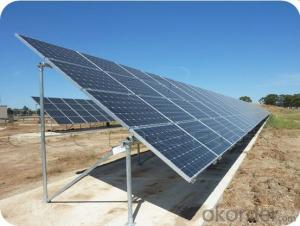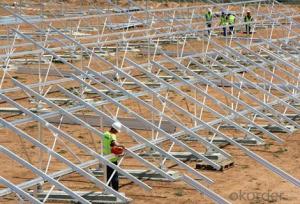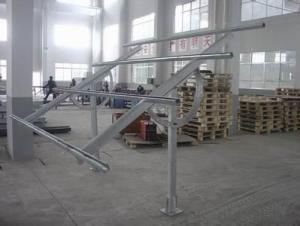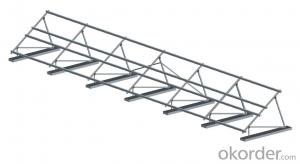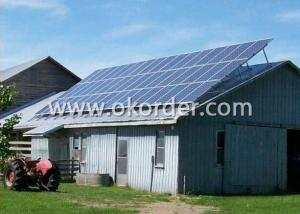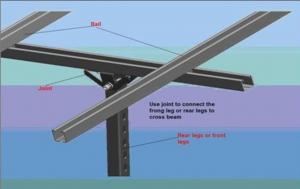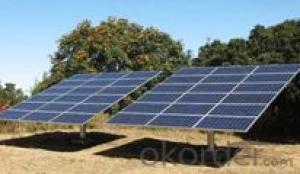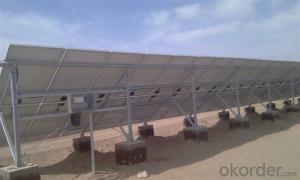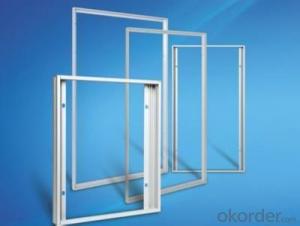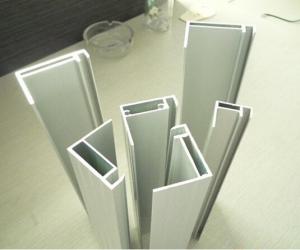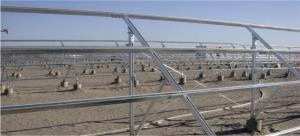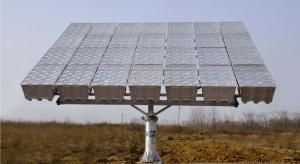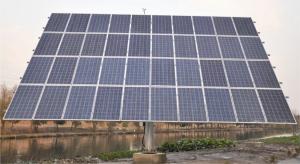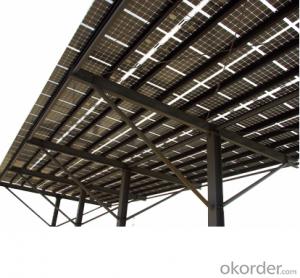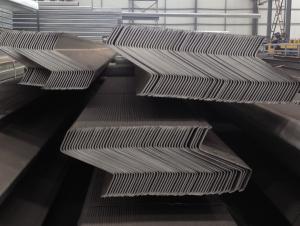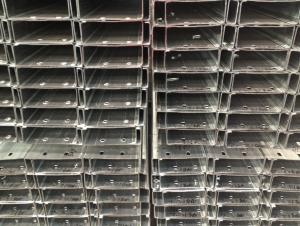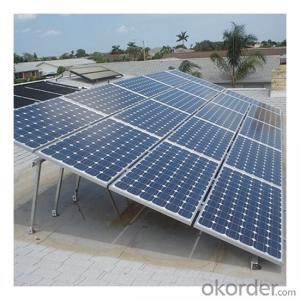Solar Panel Monting System Adjustable Tri-Bracket 1#
- Loading Port:
- Shanghai
- Payment Terms:
- TT OR LC
- Min Order Qty:
- -
- Supply Capability:
- 50万套 set/month
OKorder Service Pledge
OKorder Financial Service
You Might Also Like
PV Mounting brackets are special solar photovoltaic systemfor placing, installing, fixing the solar panel design. Generally materials arealuminum, steel structure, stainless steel. PV mounting products at groundmounting system, flat roof mounting system, adjustable angle roof rack system,inclined roof rack system, column bracket system.
The Ground Mounting System including concret basement sysytemand steel pipe sysytem, Titanergy provides total solution for flat or pitchedroof with patent products.On the basis of the given project data, specificnational standards and guidelines, Titanergy will calculate the completestructural analysis and create a complete project plan to make sure reliablestructural safety.We provide high quality HDG steel and aluminum products forthe ground mounting sysytem,witch can make sure the security and durability ofthe project.
Features and Advantages
n The rail bracket is easy to install, just use simple tools(eg, Allen wrench) can be easily installed. Rail connecting member can freelyadjust the length, the stent may be pre-installed on the roof, and thenappropriately adjusted according to the size of the solar panel.
n The combination of strong, aluminum rails and card blocks fora variety of venues and a variety of materials roofs (such as metal, ceramicand other kinds of tile surface)
n Component compatibility, and rail can meet PV modules fromdifferent manufacturers.
n accuracy, the length of the rail to the nearest millimeter,the construction process, not because of the length is too long or too shortfor the second cut.
n flexible assembly, rail hooks can adjust the spacing modulearray and tile has been installed successfully address the uneven roofconstruction led to difficult problems.
n design standards, product design and development process instrict accordance with GB, the German standards and other internationalstandards to ensure products reach the world advanced level.
n Quality assurance, the stent main material is high-qualityaluminum and stainless steel, effectively prevent corrosion of oxidation.Products can be recycled, reducing environmental pollution.
n Carried out strictly according to the current specificnational standards
n Perfectly optimized components and complete structuralanalysis for the sysytem
n High corrosion resisitance ensure the stability and highdurability
n Total test and certification make sure the high quality ofthe products
n Maximum pre-assembled in factory,quick mounting onsite,timesaving
10-year durability warranty
Technical Data
n Design Period:25 years
n Installation Site: Open area
n Array Angle:10°~60°
n ModuleType:Framed or unframed
n Material:Q235B,Al 6063-T5,Al 6005-T5,StainlessSteel A2-70
n Coating:HDG/Anodised
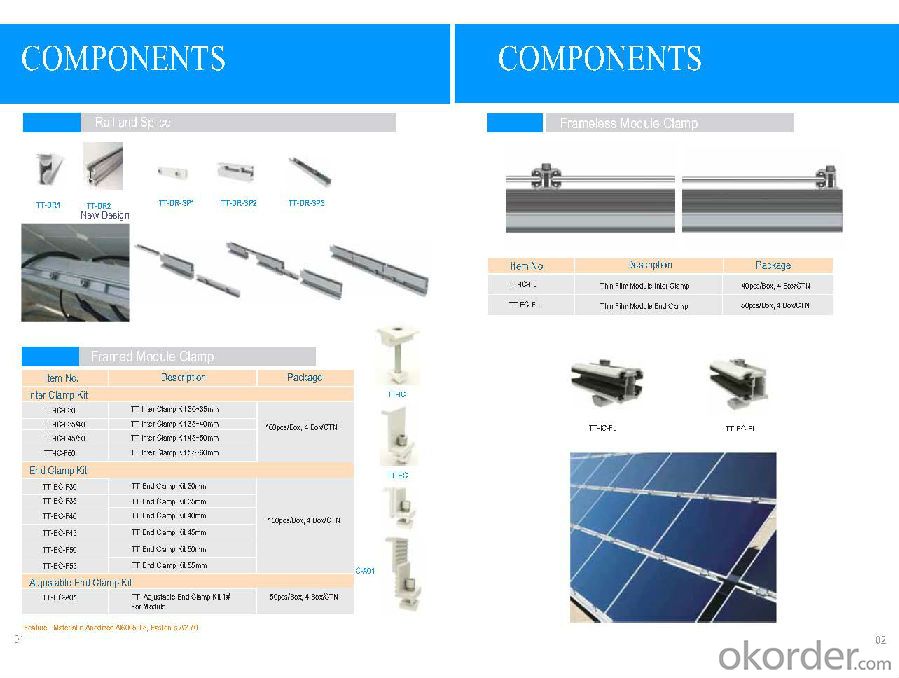

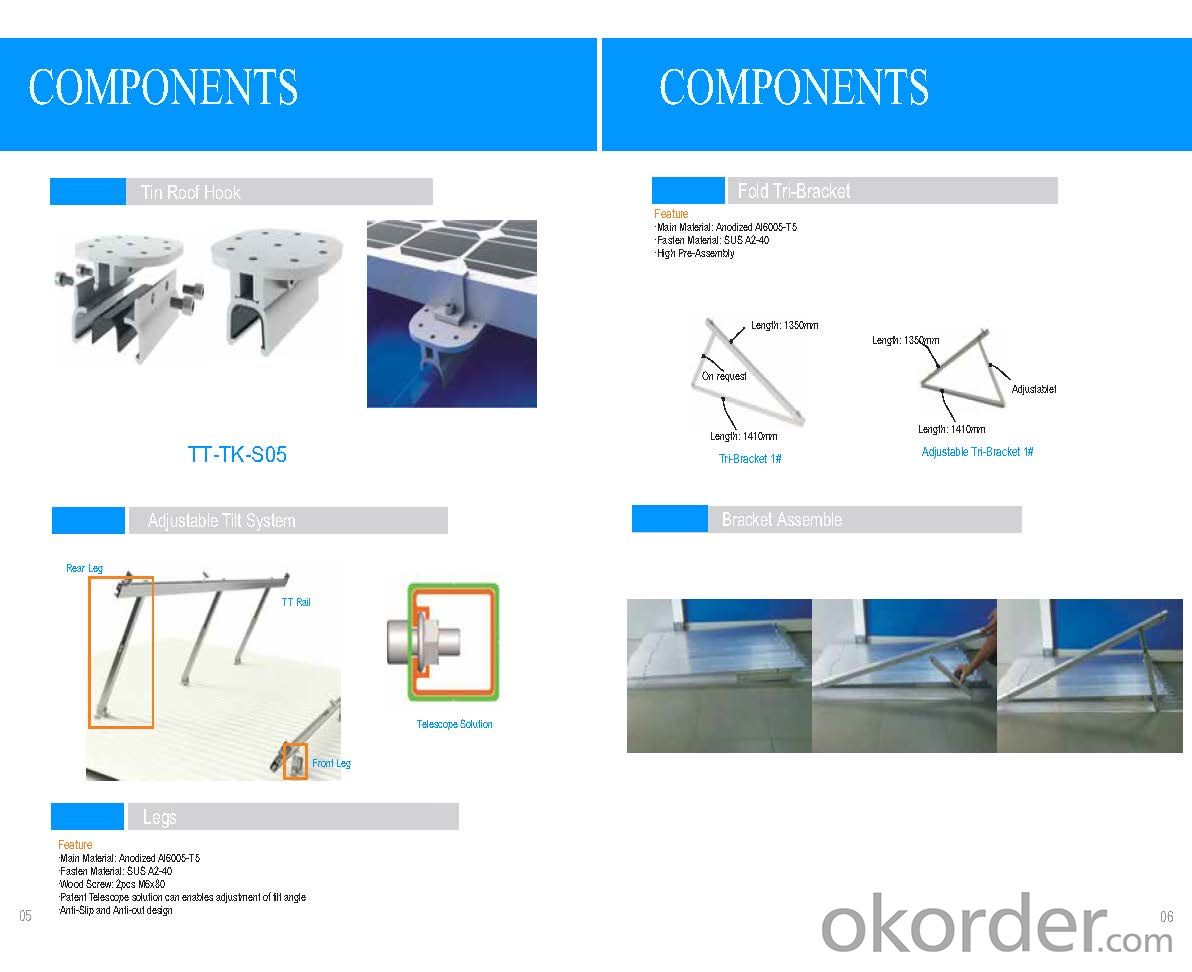
- Q:Can a solar mounting system be installed on a manufacturing or industrial plant?
- Yes, a solar mounting system can be installed on a manufacturing or industrial plant. In fact, many manufacturing and industrial plants are adopting solar energy systems to reduce their carbon footprint and lower their energy costs. These solar mounting systems can be installed on rooftops, parking lots, or even as ground-mounted systems depending on the available space. The installation of solar panels on manufacturing or industrial plants not only helps in generating clean energy but also demonstrates a commitment to sustainability and renewable energy sources.
- Q:Are there any specific requirements for seismic bracing when using a solar mounting system in seismic areas?
- Yes, there are specific requirements for seismic bracing when using a solar mounting system in seismic areas. These requirements vary depending on the local building codes and regulations. Generally, seismic bracing is necessary to ensure the solar panels and mounting structure can withstand the forces generated during an earthquake. It typically involves engineering calculations, careful design of the mounting system, and the use of appropriate anchoring and reinforcement techniques. Compliance with these requirements is crucial to ensure the safety and stability of the solar installation in seismic areas.
- Q:What is the expected lifespan of a solar mounting system?
- The expected lifespan of a solar mounting system can vary depending on various factors such as the quality of materials used, installation techniques, and environmental conditions. However, a well-designed and properly installed solar mounting system can typically last for 20 to 30 years or even longer with regular maintenance and inspections.
- Q:Are there any specific requirements for installing a solar mounting system on a rooftop with a rooftop garden?
- Yes, there are certain requirements for installing a solar mounting system on a rooftop with a rooftop garden. Firstly, the rooftop should have sufficient load-bearing capacity to support both the solar panels and the weight of the garden. It is also important to ensure that the mounting system does not damage the rooftop garden or its irrigation system during installation. Additionally, adequate space should be available to accommodate both the solar panels and the garden without compromising their functionality or efficiency. Lastly, it is crucial to consider any local regulations or permits that may be required for rooftop solar installations with a rooftop garden.
- Q:Can a solar mounting system be used in conjunction with a solar tracking system?
- Yes, a solar mounting system can be used in conjunction with a solar tracking system. In fact, many solar installations utilize both systems to maximize the efficiency of the solar panels. The mounting system provides a stable and secure platform for the panels, while the tracking system allows the panels to follow the sun's movement throughout the day, capturing more sunlight and increasing energy production.
- Q:Are there any specific requirements for awning or sunshade design when using a solar mounting system?
- Yes, when using a solar mounting system, there are specific requirements for awning or sunshade design. The design should take into consideration the orientation and tilt angle of the solar panels to ensure maximum efficiency and avoid shading. Additionally, the awning or sunshade should be structurally sound and capable of supporting the weight of the solar panels. It is also important to consider the spacing between the solar panels and the awning to allow for proper airflow and prevent overheating.
- Q:Can a solar mounting system be installed on an assisted living or retirement home?
- Yes, a solar mounting system can be installed on an assisted living or retirement home. These systems can provide numerous benefits to such facilities, including reduced energy costs, increased sustainability, and potential for backup power during outages. Additionally, solar panels can be mounted on rooftops or on the ground, making them suitable for installation on various types of buildings, including assisted living or retirement homes.
- Q:Are there regulations or permits required for installing solar mounting systems?
- Yes, regulations and permits are typically required for installing solar mounting systems. The specific requirements may vary depending on the location and jurisdiction, but obtaining permits and complying with local building codes and regulations is generally necessary to ensure the safe and compliant installation of solar mounting systems. These regulations and permits cover aspects such as structural stability, electrical safety, zoning, and fire codes. It is important to consult with local authorities or engage with a professional installer who can guide you through the necessary processes to meet all legal and safety requirements.
- Q:What materials are typically used in solar mounting systems?
- The materials typically used in solar mounting systems include aluminum, stainless steel, and galvanized steel.
- Q:Are there any building code requirements for solar mounting systems?
- Yes, there are building code requirements for solar mounting systems. These requirements vary depending on the location and jurisdiction, but generally focus on structural integrity, electrical safety, and fire protection.
1. Manufacturer Overview |
|
|---|---|
| Location | |
| Year Established | |
| Annual Output Value | |
| Main Markets | |
| Company Certifications | |
2. Manufacturer Certificates |
|
|---|---|
| a) Certification Name | |
| Range | |
| Reference | |
| Validity Period | |
3. Manufacturer Capability |
|
|---|---|
| a)Trade Capacity | |
| Nearest Port | |
| Export Percentage | |
| No.of Employees in Trade Department | |
| Language Spoken: | |
| b)Factory Information | |
| Factory Size: | |
| No. of Production Lines | |
| Contract Manufacturing | |
| Product Price Range | |
Send your message to us
Solar Panel Monting System Adjustable Tri-Bracket 1#
- Loading Port:
- Shanghai
- Payment Terms:
- TT OR LC
- Min Order Qty:
- -
- Supply Capability:
- 50万套 set/month
OKorder Service Pledge
OKorder Financial Service
Similar products
New products
Hot products
Related keywords
